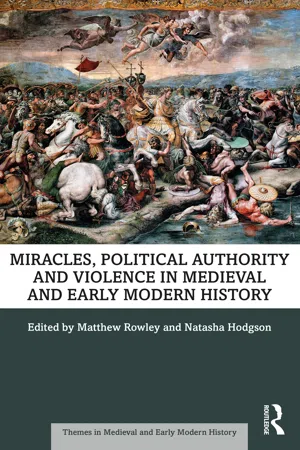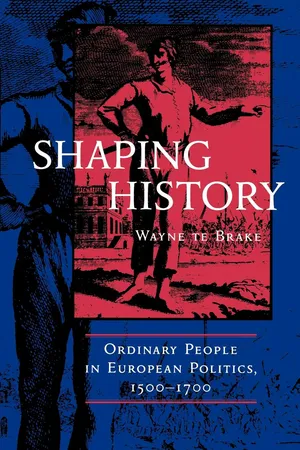History
Münster Rebellion
The Münster Rebellion was a radical Anabaptist movement that took place in the city of Münster, Germany, from 1534 to 1535. The rebellion was characterized by the establishment of a theocratic government, led by Jan Matthys and Jan van Leiden, and the implementation of radical social and religious reforms. The rebellion ultimately ended in a violent siege by the combined forces of the Catholic Church and the Lutheran rulers.
Written by Perlego with AI-assistance
Related key terms
2 Key excerpts on "Münster Rebellion"
- Matthew Rowley, Natasha Hodgson(Authors)
- 2021(Publication Date)
- Routledge(Publisher)
This chapter addresses the role of violence, miracles, and martyrdom among Irish Catholics in the 1650s. This decade has been characterised as one of great upheaval and conflict – indeed, an unmitigated disaster for Catholicism in Ireland, as English Parliamentarian forces first militarily conquered the island, before attempting to enforce a settlement involving transplantation and dispossession. These events were accompanied by violence and suffering of many kinds, including disease; food shortages; and social, religious, and political dislocation. Catholic priests especially experienced heavy persecution, with execution and exile common experiences. Amidst this distress and sorrow, Irish Catholics sought to understand events of the 1650s, to explain them to themselves and to those beyond Irish shores, and to re-establish the legitimacy of the ‘true faith’ in the face of catastrophe and the seeming victory of Protestant ‘heresy’. Particularly important were supernatural events that both warned and comforted: divine apparitions, miracles associated with martyred clergy, and the ‘strange deaths’ of persecutors. This chapter explores some of these miraculous happenings, arguing that they constituted an important avenue for Irish Catholics to criticise Protectorate policies and actions, to encourage continued faith in Catholicism itself, and to advance a narrative of suffering that placed Ireland into wider accounts of persecution, with no doubt as to the righteousness of their cause. In this, Irish Catholics were drawing on and responding to wider features in the religious landscape, including supernatural events in the 1641 Rebellion, and the claim to martyrdom by Protestants in Ireland at the hands of the barbarous Irish. The chapter therefore seeks to integrate histories of violence and religion in the 1650s into the broader British and Irish story, highlighting links and continuities with previous episodes of conflict in a decade often characterised as traumatic and transformative.Ireland in the 1650s
The 1650s in Ireland was a decade of change. The invasion of the English force led by Oliver Cromwell in late 1649 was followed by the gradual conquest of the entire island and the initiation of a number of sweeping changes in the realm of land ownership, politics, and religion. For most of Ireland’s Catholic population, it was a decade to forget but one that proved impossible to forget: the Protestant writer Vincent Gookin, writing in 1655, noted the ‘heavy pressures under which they [Irish Catholics] have groaned to the very grinding of them’ in his The Great Case of Transplantation in Ireland Discussed. He went on, ‘the sun never shined (or rather not shined) upon a Nation so completely miserable’.1 While ‘open’ hostilities ended in April 1653,2 the impact of war on the wider population persisted for long afterwards with famine, disease, and dislocation as common experiences alongside the dangers of conflict. William Petty, in his Political Anatomy of Ireland, estimated that ‘689000 souls’ were lost in the eleven years between the outbreak of rebellion in 1641 and 1652 – adding that ‘for whose blood some body should answer both to God and the king’, with this huge loss of life already a downgraded estimate compared with some contemporaries.3 Modern historians place the percentage of population loss at around 20%.4- eBook - ePub
Shaping History
Ordinary People in European Politics, 1500-1700
- Wayne te Brake(Author)
- 2023(Publication Date)
- University of California Press(Publisher)
At the time the peasant leaders were assembled in Memmingen, they can be said to have enjoyed a brief military advantage over their opponents; for the armies of the imperial Swabian League were temporarily distracted by other, more traditional military challenges. Once they turned their attention to the massive insurrections, not only in Swabia but in Franconia and Thuringia as well, the established rulers and their more practiced and professional armies easily defeated the popular challengers, sometimes even without a fight. By the end of the year, virtually all of the peasant insurrections had been subdued and a massive repression had begun throughout the area. Indeed, never again would this region be rocked by popular insurrection on such a massive scale.Because of the well-deserved fame of the Revolution of 1525, not to mention the explosion of revolutionary religious enthusiasm at the city of Münster ten years later, it is tempting to identify popular religion with popular rebellion in the early years of the sixteenth century. As it happened, however, popular movements for the reformation of religious belief and practice took a variety of forms short of open rebellion—from the submission of humble petitions to the formation of secret “conven- tides.” Moreover, “successful” reformations were as often magisterial as popular in origin. Thus the political dynamics of the English and Scandinavian reformations, where rulers actively aligned themselves with religious reform movements, were strikingly different in the 1530s and beyond. In England, for example, in the absence of massive popular demands for religious change, the king took the initiative to separate the Church from Rome and to introduce modest changes in the ritual life and dogma of the Church of which he now claimed to be the head. The most obvious popular response in 1536 was an abortive rebellion in Lincolnshire and what has come to be known as the Pilgrimage of Grace.The leaders of these English movements, like the leaders of the German revolution, put together broad but immensely fragile coalitions that could not withstand the counterchallenges of the king and his allies. Also like their German predecessors, they articulated an eclectic set of grievances and published specific demands regarding the regulation of public affairs and social relations in an agrarian society. But in the English case, instead of demanding reform or liturgical innovation, the leaders of a broadly based popular mobilization were emphatically demanding the restoration of the established Roman church and the religious practices associated with it. Meeting at Pontefract in December 1536, for example, they demanded vigorous actions against “the heresies of Luther,” among others, and insisted that “the privlages and rights of the church … be confirmed by acte of parliament, and prestes not suffre by sourde onless he be disgrecid” (Fletcher 1983:111-112). In response, a publicist for the king asked rhetorically,
Index pages curate the most relevant extracts from our library of academic textbooks. They’ve been created using an in-house natural language model (NLM), each adding context and meaning to key research topics.

